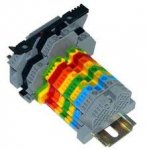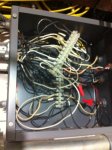mstrlucky74
Senior Member
- Location
- NJ
If you had about (40) 1p-20a branch ckts in a box(sized accordingly for box fill and conduit entering & leaving) that you had to be extended and you needed to splice them would wire nuts be the most likely scenario? Thanks.
Actually 314.28 applys only for conductors #4 or larger.
Actually 314.28 applys only for conductors #4 or larger.
Last edited:





